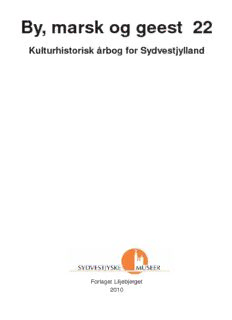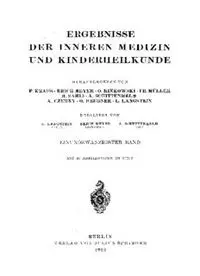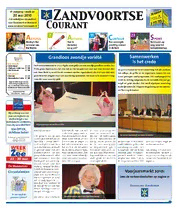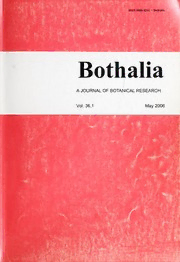
Calcium transients in isolated amphibian skeletal muscle fibres: detection with aequorin. PDF
Preview Calcium transients in isolated amphibian skeletal muscle fibres: detection with aequorin.
J. Phy8iol. (1978), 277,pp. 291-323 291 With 1 plateand 14 text-ftguree Printed in Great Britain CALCIUM TRANSIENTS IN ISOLATED AMPHIBIAN SKELETAL MUSCLE FIBRES: DETECTION WITH AEQUORIN BY J. R. BLINKS, R. RVDEL* AND S. R. TAYLOR From the Department of Pharmacology, Mayo Medical School and Graduate School ofMedicine, Rochester, Minncsota 55901, U.S.A. (Received 8September 1977) SUMMARY 1. Single twitch muscle fibres isolated from frogs and toads were microinjected withthe Ca2+-sensitive bioluminescent protein aequorin. The fibres contracted nor- mally and emitted flashes oflight (aequorin responses) in response to stimulationfor many hours thereafter. 2. No luminescence was detected from healthy fibres at rest. 3. The aequorin diffused from the site of injection at a rate consistent with a diffusion coefficient of 5 x 10-8 cm2/sec. 4. During trains of isometric contractions there was a progressive reduction in boththe amplitude and the rate ofdecline ofthe aequorin response, an observation consistent with the theory that Ca is redistributed from sites of release to sites of sequestration under such circumstances. 5. In isometric tetani light emission continued to rise long after the plateau of force hadbeen achieved. Thisandthefactthatthe amplitude ofthetetanic aequorin response increased steeply with increasing stimulus frequency suggest that in tetani the sarcoplasmic [Ca2+] may normally be above the level required to saturate the contractile apparatus. 6. Bothintwitches and intetani the amplitude ofthe aequorin responseincreased slightly and then decreased substantially as the fibre was stretched progressively beyond slack length. 7. In potassium contractures the luminescent and mechanical responses first became detectable at about the same [K+], but for equivalent force luminescence was less intense than in twitches. The aequorin response was biphasic in solutions ofhigh [K+]. 8. Exposure ofthe fibre to Ca2+-free solutionshadnoinfluence oneitherthemech- anicalortheluminescentresponses intwitches. InCa2+-freesolutionstetanicaequorin responses tended not to be maintained as well as normally, suggesting that intra- cellular Ca stores do become somewhat depleted. 9. In twitches the amplitude of the aequorin response probably reflects the amount ofCa2+ liberated intothe cytoplasm rather than a [Ca2+] in equilibrium with the myofilaments. Changes in the rate ofdecay ofthe aequorin response may reflect changes in the rate ofCa sequestration by the sarcoplasmic reticulum. *Permanent address: Physiologisches Institut der Technischen Universitat, Munchen, West Germany. 10-2 292 J. B. BLINKS, R. RUDEL AND S. R. TAYLOR 10. In K+-contractures and during the plateaus of tetani the aequorin signal changes slowly enough so that it seems unlikely that substantial gradients of[Ca2+] existatthesarcomere level. Undersuch circumstances theamplitude ofthe aequorin response probably does reflect the [Ca2+] in equilibrium with the myofilaments. INTRODUCTION ThekeyroleofCaionsinexcitation-contraction couplinginmuscleisnowgenerally accepted (forrecentreviewssee Fuchs, 1974; Ebashi, 1976). Muchisknownaboutthe way in which the interactions of the contractile proteins are regulated by Ca2+ (Weber & Murray, 1973). The function of the sarcoplasmic reticulum in main- taining a low intracellular Ca ion concentration ([Ca2+]) in the resting muscle is well established (Inesi, 1972; MacLennan & Holland, 1975; Endo, 1977). The excitatory processatthesurface membraneiswellunderstood, andagooddealhasbeenlearned aboutthemode ofspreadofexcitationintotheinternal membranesystem(Costantin, 1975). Ofall the factors involved in the control of muscular activity, least is known about the mechanisms responsible for the moment-to-moment control ofthe intra- cellular [Ca2+] duringthenormal contractions of living muscle. The development of knowledgeaboutthesemechanisms andabouttherelationofchanges in intracellular [Ca2+] to contractile function has been impeded until recently by the lack ofsuitable methods for monitoring those changes. One of the most promising approaches to the measurement of changes in cyto- plasmic [Ca2+] hasinvolvedtheintracellular injection of the Ca2+-sensitive biolumi- nescent protein aequorin. This substance, first isolated by Shimomura, Johnson & Saiga (1962) from theluminescent jellyfish Aequorea, emits blue light in the presence ofeven verylow[Ca2+], isrelativelyspecific for Ca2+, andrequiresno other cofactors (forreviewseeBlinks, Prendergast & Allen, 1976). Itwasfirstusedasanintracellular Caindicatorinthegiant barnacle muscle fibre byAshley & Ridgway (1970), and has subsequently found application in a variety ofother cells (for references see Blinks, 1978). Known difficulties associated withthe method are that aequorin is consumed in the luminescent reaction, that the relation between [Ca2+] and light intensity is not linear, that the sensitivity of the indicator to [Ca2+] is influenced by the com- position of the cytoplasm, and that the kinetics of the luminescent reaction limit the ability of aequorin to track very rapid changes in [Ca2+] (see Discussion). Nevertheless, a large amount ofuseful information can be obtained from aequorin- injected cells despite these limitations. AlthoughthestudiesofAshley &Ridgway (1970) yieldedvaluableinsightsintothe regulation ofcontraction, theirresultswiththegiantbarnacle muscle fibre cannot be related directlytothebodyofinformationthat hasbeenaccumulated overtheyears on the mechanism of contraction ofvertebrate striated muscle, particularly amphib- ian twitch muscles. The development of techniques for preparing, handling, and injecting concentrated solutions of aequorin through very small pipettes has now progressed to the point where it is possible to record luminescent responses from single amphibian muscle fibreswith afair degree ofregularity. This paperrepresents a general description of the characteristics of those signals and the ways in which theymay be modifiedbysomeimportantphysiologicalvariables. Preliminaryreports CALCIUM TRANSIENTS IN AMPHIBIAN MUSCLE 293 of some of our results have already been presented (Rudel & Taylor, 1973; Rudel, Taylor, Blinks & Mattingly, 1973; Taylor, Rudel & Blinks, 1975; Rudel, Blinks & Taylor, 1976). METHODS Preparation, mounting, and8timulation ofmusdeftibre8 Single twitch muscle fibres were dissected from the tibialis anterior and semitendinosus muscles of the frogs Rana temporaria and R. pipien8, and from the tibialis anterior and ilio- fibularis muscles of the toad Xenopu8 laevis. Rana temporaria were obtained from the Frog Farm, County Meath, Ireland; the other species were purchased from Mogul-Ed, Oshkosh, Wisconsin, U.S.A. Dissections were carried out in a physiological salt solution (composition given below) containing 1-5x 10-5M-(+)-tubocurarine. The fibres were prepared with short tabsoftendoninwhichpinholesweremadefortheinsertionofhooks. Forinjection,microscopic inspection, andmostexperiments, thefibresweresuspendedhorizontallyinashallowuncovered glass-bottomed bath mounted on a temperature-controlled stage. For studies in which the bathingsolutionhadtobechangedrapidly, thefibresweretransferred afterinjectiontoasmall covered flush-through chamber similar in principle to that described by Hodgkin & Horowicz (1959). All results presented in this paper were obtained with an isometric recording system. The fibres were suspended between two fine stainless-steel hooks, one ofwhich wasfixed tothe bath, andtheotherattachedto aforcetransducer. AnRCA 5734mechanoelectronic transducer tube was used in many ofthe experiments; this was subsequently replaced by an AME Model AE strain gauge transducer (Aksjeselskapet Mikroelectronikk, Horten, Norway). The trans- ducer was mounted on amicrometerslide which was used to adjust thefibrelength. The fibres were stimulated with square-wave pulses of 0-5msec duration and about twice threshold strength which were derived from a digital programmer and pulse generator and delivered through a Hewlett Packard 6824A DC amplifier. In the open bath, the stimulating electrodes were a pair of bright platinum plates 10mm apart, extending the depth of the chamber and morethanthelengthofthefibre. Intheflush-throughchamber,theywereplatinumwires3mm apartrunningparallel to thefibre along opposite sides ofthe chamber. Before aequorin was injected, the contractile responses of the fibre to single pulses and to tetanic stimulation were recorded. The dimensions of the fibre were measured and sarcomere spacing in the region to be injected was estimated for at least one setting of fibre length by counting striations with a microscope (Zeiss-Oberkochen 40x water immersion objective, N.A. 0-75, orNikon 20x waterimmersionobjective, N.A. 0-33). Inafewfibresthecontractions were filmed at 20-50 frames/secbefore and after the injection of aequorin. Methods for cine- micrographywereessentiallythesameasthosereportedpreviouslybyCostantin &Taylor(1973). Solutions The standard physiological salt solution contained (mM) NaCl 115, KCl 2-5, CaCl2 1-8, Na2HPO4 2-15,NaH2PO4 0-85;thepHwas 7-2. Ca2+-free solutionwasidenticaltothestandardsolutionexcept that CaCl2wasomitted and3 mM-MgCl2 and 3mm-EGTA (ethyleneglycol-bis(fl-aminoethylether)-N,N'-tetraacetic acid) were includedinstead (Stefani &Chiarandini, 1973). High Ca2+ solution contained only 83m -CaCl2 and 2-5m -KCI (DeMello, 1973). High K+solutionsweremadewithmethanesulphonateastheimpermeant anion tomaintain a constant [K+]x[Cl-] product, 2 mM-MOPS buffer (3-(N-morpholino)propanesulphonic acid) to maintain the pH at 7-2, 1jug tetrodotoxin/ml. to prevent sodium-dependent propagated responses, sucrosetomaintain aconstant osmotic strength, and 1-8 mm-Caacetate. Inorganic saltswereFishercertifiedreagentgradeexceptforNaClwhichwasbiologicalgrade. EGTA andmethanesulphonic acidwere obtained fromEastman Organic Chemicals; MOPS and tetrodotoxin from Sigma Chemical Co.; (+)-tubocurarine from E. R. Squibb & Sons; caffeine fromEliLilly &Co. Preparation ofaequorin Aequorin, extracted from specimens ofAequorea (collected at Friday Harbor, Washington), waspurified in 10mM-EDTA (ethylenediaminetetraacetic acid) byafive-step sequence. 1. Differential ammonium sulphate precipitation (25-75% ofsaturation cut). 294 J. R. BLINKS, R. RUDEL AND S. R. TAYLOR 2. Gelfiltration on Sephadex G-50 (fine). 3. Ion-exchange chromatographyonQAE Sephadex (A-50)withpHstepand[NaCl]gradient elution. 4. Gelfiltration onSephadex G-50 (fine). 5. Ion-exchange chromatography on DEAE Sephadex (A-50) with[NaCl] gradient elution. The product was shown byisoelectric focusing to be a mixture of luminescent proteins with isoelectric pointsbetweenpH 4-4and 4.7. Polyacrylamidegelelectrophoresisrevealedno bands detectablewithCoomassie bluestainingthathadnotemittedlightwhenthegelswereimmersed in CaCl2. Densitometric scanning of gels after sodium dodecyl sulphate gel electrophoresis indicated that about 97% ofthe protein present ran asasingle band. The specificphotonyield ofthe product was 1-6x 1016 photons/mg, calculated frommeasurements oflightyield at 220C calibrated against the radioactive light standard ofHastings & Weber (1963) and on the basis ofanextinctioncoefficient (El% )at 280nmof27 (Shimomura &Johnson, 1969). The purified aequorin was freed ofNaCl and EDTA bypassage through a 100cmcolumn of SephadexG-25 (medium), equilibratedandelutedwith 10mM-ammoniumacetatethathadbeen decalcifiedbypassagethroughacolumnofChelex 100 (Bio-RadLaboratories) intheammonium form. The aequorin was then lyophilized in the presence ofChelex 100beads. Since ammonium acetatesublimesduringlyophilization,theproductwasvirtually salt-free. Forintracellularinjec- tion, thelyophilized aequorin wasdissolvedin140mM-KClwhichhadbeenfreedofCabypassage throughacolumnofChelex 100inthepotassium form. (KC1was usedratherthan distilledwater sothat conductivitywouldbehighenoughtoallowmembranepotentialsto bedetectedwiththe injectionpipette.) Thissolution, whichhad aconcentration ofactiveaequorin (determinedfrom light yield) between 1 and 3mg/ml., was filtered just before use bypassing it through a small disk of0-1Aim Millipore filter in a miniature holder made for the purpose. For details ofthese procedures see Blinks et al. (1978). Injection ofaequorin Pipettes formicroinjectionwerepulledfromacid-washedglasswithastandardmicroelectrode puller (Industrial Science type M-1); the puller was adjusted to produce abruptly tapered pipettes with tips small enough so that cells could be impaled without producing local contrac- tures butlarge enoughsothatnanolitervolumes offluid couldbeexpressedinafewsecondsby the application ofgas pressure to solutions inside. Satisfactory pipettes had resistances of 3-5 MCIwhen filled with 3 M-KC1. The tips were too small to be resolved under green light with the lightmicroscope (oilimmersion objective, N.A. 1.30). The pipettes were filled from the butt; a small amount (2-5F1.) of freshly filtered aequorin solution was deposited at the shoulder ofthe pipette with afinely drawn-out piece ofpolyethy- lenetubingattached to a 51d. Eppendorfpipette. Airbubbles were dislodgedfromthetip ofthe pipette with a carefully washed, tapered glass filament. The pipette was then mounted in a holder similar in principle to that described by Grundfest, Kao & Altamirano (1954) which enabled us to inject and monitor the membrane potential through the same pipette. A washed platinum wire (silver rapidly inactivates aequorin) made contact with the aequorin droplet and nitrogen pressure could be applied to the inside ofthepipette. For injection, the isolated muscle fibre was stretched until it was somewhat taut (sarcomere spacing 2-6 escm or more). To stabilize the fibre a small fire-polished glass rod was sometimes brought up against its mid-section with one micromanipulator. The injection pipette was positioned near the fibre with a second micromanipulator, and its patency verified by ejecting aequorin into the Ca2+-containing physiological salt solution while light emission was recorded. The fibre was then impaled under visual control. The potential difference between the platinum wires in the bathing solution and in theinjection pipette wasmonitored as anindicator ofmem- brane penetration. Whenpenetration was verified byasudden change inpotential, pressurewas applied to the pipette (usually intermittently) and gradually increased (from less than one to 5 or more atm) until the fibre swelled visibly around the site ofimpalement. When the pressure was released, the swelling rapidly subsided. The injection pipette was withdrawn from the cell and removed from the vicinity of the muscle bath (because the relatively large amount of aequorin remaining in the pipette emits a substantial amount oflight no matter how carefully thetubinghasbeencleaned). Themusclefibrewasthentestedforitsability tocontractnormally and to emit light on stimulation. Ifthe amount oflight was judged insufficient for satisfactory recording, one or more additional injections were attempted. CALCIUM TRANSIENTS IN AMPHIBIAN MUSCLE 295 On oneoccasionimmediatelyafterasuccessfulinjection, aswellasat theend ofmanyofour usual experiments, the muscle fibre was transferred to the cuvette of a calibrated integrating photometer forthepurpose ofdetermining theamount ofactive aequorin inthefibre. Thefibre wasplaced inthecuvetteinapproximately0-5ml. ofthehigh-Ca2+solution. The aequorin was then discharged by injecting 0-5ml. 50mm-caffeine into the cuvette while the integrated light output was recorded. Muscle fibres were sometimes damaged during attempts to inject them, as was evidenced by the development ofalocal contracture around the injection site. Ifthebreakin the membrane was not too severe, it could often be resealed without discharging the injected aequorin by exposingthefibre to the high-Ca2+ solution (DeMello, 1973) for a few minutes. When returned to the normal physiological salt solution, fibres that had been treated in this manner appeared normal, contracted normally, and showed aequorin responses that were indistinguishable from those offibres that had been injected without any apparent damage. Nevertheless, the results that we considermost reliable were obtained fromfibresthat hadsufferedno apparent trauma, andsurvivedformanyhoursgivingstablemechanicalandluminescentresponsestostimulation. AllFiguresinthispaperweremadefromfibresofthistype. Lightrecording The muscle bath was mounted in a totally darkened room adjacent to the laboratory con- taining most ofthe electronic equipment. The onlypotential source of background light in the dark room was the RCA 5734 transducer tube, and that was coated with a dense black paint. The pipette used for injecting aequorin was removed from the room, and no fluorescent lamps werepresent. Lightfromthemusclefibrewasdetectedwithphotomultipliertubesmountedinseveralways. For most purposes, an EMI 9635B photomultiplier was mounted directly under the bath with the 45mmphotocathode as close (35mm) to the muscle fibre as the dimensions ofthe housing andshutterwouldpermit. Thesolidanglesubtended bythephotocathode wasthus 1 steradian, or8%ofthetotalsolidangleaboutthelightsource. Lightfromthemusclefibrepassedthrougha clear acrylic plastic window in addition to the glass bottom of the muscle chamber and the window of the photomultiplier tube. At other times the photomultiplier was mounted above the preparation with either a 25mm diameter polished acrylic plastic rod, or a 10x 15mm rectangularglassfibre-opticlightguideextendingfromthesurfaceofthemusclechambertothe shutterofthephotomultiplier. Whenthedistribution oftheinjectedaequorinwastobestudied, two photomultipliers were used simultaneously (the EMI 9635B mounted directly below the muscle chamber and an EMI 9502 B connected to a thin (0-5mm) fibre-optic probe that was used toscan thelengthofthemusclefibre). The photomultipliers were operated at room temperature with the anode at virtual earth potential. The overall voltage applied to the dynode chain was 1100V in the case ofthe EMI 9635 B; 1300Vfor the 9502 B. Lightsignalswererecorded eitherwith Zeltex ZA 801M1 opera- tional amplifiers wiredto convert anode current to voltage signals, orwith an SSRModel 1120- 11-5 photon counting system. The latter system includes an amplifier-discriminator which converts separate electron cascades from the photomultiplier into pulses ofuniform amplitude andduration. These are both counted digitally and converted to an analoguesignal byfeeding them, after fourfold prescaling, into an operational amplifier wired as a 'leakyintegrator'. The time constant ofthe analogue lightrecording systemwas < 1 msec exceptintheexperimentson potassium contractures when it was 10msec. Thephoton-counting systemwas used inaneffort tomeasurethelightemittedbymusclefibresatrest.Theanalogueoutputofthephoton-counting system hadnoparticularadvantage overasimple record ofanodecurrent forthemeasurement ofrapid Ca transients, but was often used for that purpose so that attempts to detect aresting glowcould bemade conveniently fromtime totimeduringanexperiment. The light and force signals, stimuli, and oscilloscope triggering pulses were recorded simul- taneouslywithachartrecorder andwithanAmpex SP-300FMtaperecorder (signaldown 2 db at625Hzattapespeedused). TherecordsshownintheFiguresofthispaperwereallmadefrom thetaperecordings; signalswereeitherphotographed directlyfromanoscilloscope screen (white on black) or read out at low speed on an X-Y plotter (black on white) after temporary storage in the digital memory ofa Nicolet 1074 instrument computer. In some cases (indicated in the Figurelegends) repetitive signals wereaveragedwiththeNicoletinstrument. 296 J. R. BLINKS, R. RUDEL AND S. R. TAYLOR RESULTS Most of the experiments reported here were carried out on muscle fibres from Rana temporaria. Results from the other species studied were qualitatively similar; the origin ofthe muscle fibre used is indicated for each Figure. Influence ofthe aequorin injection On several occasions theratherrapidinjection processwas filmed at 20-50frames/ see through a compound microscope. When the films were projected in slow motion, it appeared that the injected solution lifted the surface membrane slightly from the underlying material and distributed itself in a patch some 100,m in diameter around the tip ofthe pipette (see PI. 1). The swelling ofthe fibre at the injection site subsided within a few seconds after the pressure was removed. When the pipette was first removed there was sometimes a small pimple in the surface membrane, but in fibres that survived the injection this soon disappeared, leaving no visible sign at the site ofinjection. Assays carried out on a number offibres at the end ofthe experiment and also on one freshly injected fibre indicated that the injection of about 1 nl. of a solution containing aequorin in a concentration of 1-3 mg/ml. was sufficient to give lumin- escent responses for twitches in which the peak photomultiplier signal was at least 30 times the dark current or count. The amount of aequorin usually injected is estimated to have been ofthe order of 1-5 ng. Neither the injection nor the presence of aequorin appeared to influence the mechanical function ofthe muscle fibres asjudged by any ofthe criteria available to us. The fibres responded with large force and light signals after local stimulation at one end, as well as after the transverse field stimulation normally applied. The tension records made in isometric twitches and tetani after the injection did not differdiscerniblyfromthose madebefore. Duringisometrictetani,theinjected region ofthe fibre did not appear different or behave differently from the rest ofthe cell, either when it was viewed directly through the microscope, or when cine-films of contractions were projected in slow motion. Therefore, the action potential presum- ably propagated throughoutthefibreand excitation-contraction coupling proceeded in an essentially normal manner after the injection. Aequorin-injected muscle fibres continued to behave normally throughout experiments lasting eight hours or more. Diffusion ofaequorin within the musclefibre Toestimatehowrapidlytheaequorinspreadfromthesiteofinjection,weusedathin (0.5mm diameter) fibre-optic probe to scan the light emission along the length ofthe muscle fibre. The probe was mounted in amicromanipulator, andwas held about 0-5mm above the fibre. It was then moved in 0-2mm steps along thelength ofthefibre. At eachstep thefibre was stimulated togiveabrieftetanus, andthelightwasrecordedsimultaneouslythroughtheprobeandwiththe large-aperture photomultiplier mounted beneath the muscle chamber. Thelight measured with theprobewasexpressedasapercentage ofthatrecordedthroughthelarge-aperturephotomulti- plier in order to correct for any depletion ofthe aequorin during the course ofthe experiment. The scan was repeated at intervals of several hours to determine how far the aequorin had spreadfromthe site ofinjection. Text-fig. 1 showsresults fromthelongest ofthree such experi- ments. The points represent the peaks of the aequorin responses recorded with the scanning probe,normalizedtothepeakoftheaequorin responses recordedwiththelargephotomultiplier CALCIUM TRANSIENTS IN AMPHIBIAN MUSCLE 297 atthattime. Thefibrewasscanned 2-3, 5-3, and9-3hraftertheinjection andaspreadingofthe aequorinduringthis 7 hrperiodis quiteobviousfromthesethreesetsofmeasurements. ThecurvesdrawninText-fig. 1 aretheoretical onescalculatedfromtheequationfordiffusion in one dimension (Crank, 1956, p. 10) C exp(-x2/4Dt) M 2VirDt whereCisthe concentration inaplane at distancex fromthesite ofinjection, Mistheamount ofsubstance injected at t = 0 and x = 0, t is the time after injection, and D is the diffusion coefficient. Strictly,theequationshouldtaketheinitialshapeoftheinjectedbolusintoconsidera- tion, but after the early period ofredistribution the results should not be greatly influenced by our assumption ofan initial planar distribution. The distributions obtained with this equation were convolved with an empirically determined acceptance function that tookinto account the width ofthefibre-optic probeandthefactthatitacceptedlightfromaconicalspace, notsimply from the point immediately beneath its axis. The curves shown in Text-fig. 1 were calculated with a diffusion coefficient D = 5x 10-8 cm2/sec. Curves calculated with D = 3x 10-8 and 1 X 10-v cm2/secgavesubstantiallyworsefitstotheexperimentalpoints. 2 3 hr 5 3 hr 9-3 hr 1 ^ after injection C0)5 -1 0 +1 0 +1 -1 0 +1 Distance from injection (mm) Text-fig. 1. Diffusion of aequorin from the site of injection. Single fibre from semi- tendinosus muscle of Rana temporaria. Striation spacing 2-3#um; temperature 15 °C. The fibre was injected with aequorin at a single point near its middle. Light was re- corded with a 45nun photomultiplier mounted directly under the muscle chamber, and also through a thin (0 5mm diameter) fibre-optic probe held in a micromanipu- lator. Theprobewasheldsothatitalmosttouchedthefibre, andwasmovedin0-2nun stepsto scan thelength ofthefibre. At each position, the muscle was stimulated with a brief (0 1 sec) 77Hz tetanus. Successive scans were made 2-3, 5 3, and 9 3hr after the injection. The points show the light intensity measured through the fibre-optic probe normalized with respect to the light intensity recorded (with the large-aperture photornultiplier) from the whole fibre. The curves show the distribution of light in- tensities (corrected for light acceptance by the probe) that would be expected if aequorinspreadfromthesiteofinjectionwithadiffusioncoefficientof5x 10-1CM2/sec. Luminescence in restingfibres Although there is no level of [Ca2+] below which aequorin luminescence does not occur (see Allen, Blinks & Prendergast, 1977), wewere unabletodetectluminescence from healthy aequorin-injected muscle fibres at rest. In an effort to measure the level of luminescence at rest, we used the photon counter in conjunction with an 298 J. R. BLINKS, R. RUDEL AND S. R. TAYLOR EMI 9635 B photomultiplier tube that had a dark count of about 80/sec at 20 0C. Theshutterbetweenthe musclebathandthephotomultiplier wasalternately opened and closed for 1-5 min periods while the photon count was accumulated digitally. Although counts were made for aggregate periods of up to 30 min at various tem- peratures between 5 and 15 0C, we never found in healthy fibres that there was a significant difference between counts during the times thatthe shutter was open and closed. This wastrue whetherthe fibre was at slacklength or stretchedto a striation spacing of 3-6 gm or more. A few fibres that had been visibly damaged did have a resting glow shortly before they lost the ability to respondto stimulation. IiO nA I2 mN L~ ] 200 msec Text-fig. 2. Luminescent and mechanical responses in isometric twitches. Single fibre from tibialis anterior muscle of Rana temporaria. Striation spacing 2-3Aim; tem- perature 10 'C. Left panel shows records oflight (noisy trace) and force from a single rested-state contraction. In the right panel seven such twitches have been averaged to reduce photomultiplier shot noise. The time of the stimulus is indicated by the verticalmarkbelowthebaseline. The aequorin response to a single stimulus Aequorin-injected muscle fibres emit readily detectableflashes of light ('aequorin responses') in response to individual electrical stimuli. The intensity ofthese flashes varies withthe amount ofaequorin that has been injected, but the time course does not. The left-hand panel ofText-fig. 2 illustrates the characteristics ofthe aequorin response and associated force development in a singlerested-state twitch. (Rested- state contractions are defined as those preceded by a period ofrest long enough so that the influence of previous activity is no longer detectable (Blinks & Koch- Weser, 1961).) In the right-hand panel, seven such signals have been averaged in order to reduce photomultiplier shot noise. The light and force signals usually begin to rise nearly simultaneously, thoughthe change in force may lag a few milliseconds behind the light. The luminescent response reaches its peak well before the mech- anical, usually at about the time that the rate of force development is maximal. This correspondence is not precise, however; the relation varies somewhat from fibre to fibre, and is influenced by temperature and fibre length. The light intensity decays approximately exponentially, and usually has declined to less than 50% of itspeaklevel bythetime peak force isachieved. Our experimental procedure was such that we normally started recording light signals within a few minutes after the injection, and the rested-state aequorin CALCIUM TRANSIENTS IN AMPHIBIAN MUSCLE 299 responsewasalwaysessentiallyconstantthereafterunlesstheexperimentalconditions were changed or the fibre was subjected to frequent tetanic stimulation (in which case the aequorin was sometimes depleted significantly). On several occasions we recorded aequorin responsesfrom muscles stimulated to twitch regularlyatintervals of20-300 sec forperiods of2-4 hr. There wasno regular tendency oftheluminescent response to change with time during these periods. After a successful injection a muscle fibre could usually be used in an experiment for at least eight hours; during 20 "C 6DC Light - Force- 10 'C 25 C L() 15 'C 30TC [ z E LO I 1~~~~~~~~~~~~~~~~~~~~ 200 msec Text-fig. 3. Influence of temperature on luminescent and mechanical responses in rested-state contractions. Isometric contractions ofa single fibre from semitendinosus muscleofRanatemporaria;striationspacing2 3fm;temperaturesasindicated. Calibra- tionsarethesameforallpanels. this time it could be stimulated to give thousands of twitches or dozens of tetani without a major reduction ofthe aequorin response. On several occasions we have recorded aequorin responsesformorethan 24 hraftera single injection. Experiments were usually terminated byexhaustion ofthe fibre orthe experimenters, rather than by that ofthe injected aequorin. Variations in temperature alter the amplitudes ofthe luminescent and mechanical responses in opposite directions. Text-fig. 3 shows a series of six rested-state con- tractions recorded from the same fibre at various temperatures. In this experiment 300 J. R. BLINKS, R. RUDEL AND S. R. TAYLOR the peak intensity of the aequorin response increased 2-6-fold as temperature was raisedfrom 6to 30 'C, whiletherewasa40% decreaseinthepeaktensiondeveloped. Both the luminescent and the mechanical responses become briefer as the tempera- ture is raised. Although the time courses of the two responses are influenced in qualitatively similar ways by changes in temperature, the temporal relations be- tween the two are modified somewhat. The tendency for the aequorin response to lead the mechanical one is more pronounced at low than at high temperatures: although the aequorin response always reaches its peak before the tension response does, the temporal discrepancy is relatively less pronounced at higher temperatures. Similarly, the tendency for the luminescent response to return to its baseline before the completion ofrelaxationis much morepronounced (inbothabsolute andrelative terms) atlowtemperaturesthanathigh. Aequorin responses during repetitive stimulation When trains of stimuli are applied to an aequorin-injected muscle fibre, the luminescent responses undergo progressive changes that suggest the operation ofat least two progressive or cumulative processes. The patterns of these changes vary considerably with the temperature and stimulus frequency (Text-fig. 4), with the result that the individual processes are most evident under different experimental circumstances. The two processes are manifest as (1) a descending staircase ofpeak light intensity, and (2) aprogressive slowing ofthedecayofthe aequorinresponse. The descending staircase. When a train of low-frequency stimuli is applied to a muscle fibre after a long period ofrest, the first stimulus elicits a rested-state con- traction. Subsequent responses form a characteristic descending staircase of peak light intensity that is obvious at all frequencies up to those producing a high degree of fusion of successive aequorin responses. The descending staircase is relatively brief, and at 15 0C is essentially complete within ten to fifteen contractions (Text- figs. 4 and 5). Stimulation can then be continuedindefinitely withoutfurther change inthe amplitude ofthe aequorin response. The approach tothe steady state is faster at lowtemperatures thanat high (Text-fig. 4). It alsobecomes fasterwithincreasing stimulus frequency in such a way that the number ofstimuli required to reach the steady state is roughly constant at any given temperature (Text-fig. 4). The extent to which the light intensity falls during the descending- staircase increases with increasing frequency up to the point that the fall is distorted or cut short by the summation of successive responses. When a high degree of summation occurs, the initial descending staircase may be obscured altogether (Text-figs. 8 and 11). The pattern ofmechanical responses during the early part ofa train oftwitches is considerably more variable than that ofthe aequorin responses. In our experiments peak force usually rose somewhat over the first two or three twitches, and then fell slightly during the time that there was a descending staircase ofaequorin responses (Text-fig. 4: 5 Hz and 10 Hz; Text-fig. 5). Sometimesthese changes werefollowedby a long gradual rise in peak force. The relative prominence of the three mechanical changes was variable, and all were small in comparison to the descending staircase occurring simultaneously intheaequorin response. Slouing of decay. Although it is relatively inconspicuous in trains of unfused twitches, there is always a progressive increase in the half-time with which the
Description:The list of books you might like

The 48 Laws of Power

$100m Offers

Atomic Habits James Clear

A Thousand Boy Kisses

Microtus hyperboreus (Mammalia, Rodentia) in south-eastern Yakutia

By, marsk og geest 22

Ergebnisse der Inneren Medizin und Kinderheilkunde: Einundzwanzigster Band

But on A Quiet Day . . . A Tribute to Arundhati Roy

BİBLİYOGRAFYA Kitaplar OCAK, Ahmet Yaşar (1980), Babaîler İsyanı, İstanbul

Convert JPG to PDF online

Demographic & economic information for Yellowstone County

Greek Government Gazette: Part 2, 2007 no. 1295

C-3PO: Tales of the Golden Droid

C++ AMP. Построение массивно параллельных программ с помощью Microsoft Visual C++.

Spezielle Magenchirurgie

Archives of Disease in Childhood 1993: Vol 69 Table of Contents

New records and host plants of fly-speck fungi from Panama

DTIC ADA550999: Comment on The Two-Capacitor Problem Revisited: A Mechanical Harmonic Oscillator Approach

Zandvoortse Courant 2010 week 20

Bezgrješna

Shafer Court connections

The Story Girl by L. M. Montgomery


